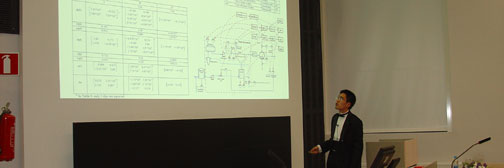| | Year 2006
Peter BlanzImproving a Grinding Mill Filling Measurement
Grinding is an essentially important and very energy-consuming unit process in the production chain of a concentrator. Therefore, there are strict demands on the operation of the most important piece of equipment in the grinding process, the grinding mill. One of the quantities best describing the state of the grinding mill is the mill filling, which is challenging to measure. The objective of this work was to further develop a grinding mill filling measurement based on power-oscillation. The main goal was to improve the measurement's reliability during special circumstances, where the power signal is weak.
Another objective was to improve the calculation of the initial filling value required by the method at mill start-up. Additional goals included modeling the amount and trajectories of grinding media in the mill and modeling the mill's shell liner wear.
Different methods for mill filling measurement, grinding media trajectory modeling and liner wear modeling are investigated in the literary study. Since the measurement methods are used in the control of the grinding process, grinding control strategies are briefly discussed as well.
In the experimental part, a tried and well-known model was slightly modified and then implemented to model the grinding media trajectories. An extended Kalman filter was developed to improve the measurement's reliability. The filter can be used to estimate charge volume based on the mill power draw and bearing pressure. The same estimate can be used at mill start-up. The filter utilizes grinding mill bearing pressure and power draw models in its calculations. Since these quantities depend largely on the amount of grinding media (balls) in the mill and the mill filling, the filter can be used to estimate the amount of balls in the grinding mill. For the trajectory model to yield useful results and for the power model to be as accurate as possible, the mill's shell liner wear was also modeled. For this purpose, a model that takes into account the changing of the lifter bars' dimensions, as well as the rounding of the bars' corners, was developed. All of the features were initially tested using simulated data.
The improvement in the measurement's reliability was put to test with a piece of data, obtained from a concentrator. The data contained a section of weak signal, which had previously been found to cause problems. With the filter in use, the measurement handled this problematic section correctly. The ball charge estimate was tested in industry-scale by skipping a grinding mill's scheduled ball additions for several days. The estimate was realistic. The modeled trajectories and wear profiles were compared against measurements found in literature, and both models were found precise. The implementing of the developed features in a commercial product has started.
This info last modified 27 Apr 2024 by Jerri Kämpe-Hellenius
|

